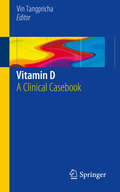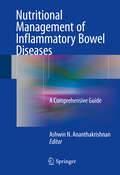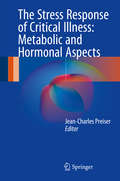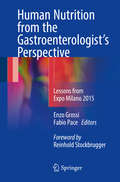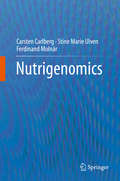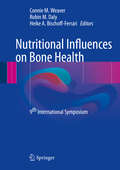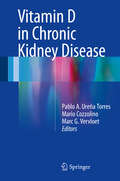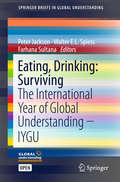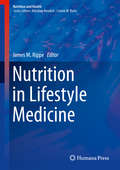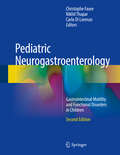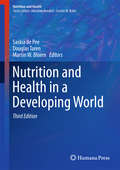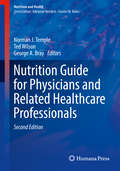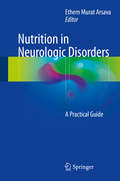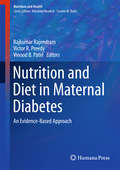- Table View
- List View
Vitamin D: A Clinical Casebook
by Vin TangprichaComprised exclusively of clinical cases covering disorders of vitamin D and its clinical management, this concise, practical casebook will provide clinicians in endocrinology with the best real-world strategies to properly diagnose and treat the various forms of the condition they may encounter. Each chapter is a case that opens with a unique clinical presentation, followed by a description of the diagnosis, assessment and management techniques used to treat it, as well as the case outcome and clinical pearls and pitfalls. Cases included illustrate different causes of deficiency as well as management strategies, including deficiency in healthy patients and infants, in eating disorders and gastric bypass, surgical and chronic hypoparathyroidism, and chronic kidney disease, among others. Pragmatic and reader-friendly, Vitamin D: A Clinical Casebook will be an excellent resource for clinical endocrinologists, nutritionists, and family and emergency medicine physicians alike.
Nutritional Management of Inflammatory Bowel Diseases: A Comprehensive Guide
by Ashwin N. AnanthakrishnanThis book is a state-of-the art review for clinicians and dieticians with an interest in nutrition and inflammatory bowel diseases (Crohn’s disease, ulcerative colitis). The volume covers new data about dietary risk factors for Crohn’s disease and ulcerative colitis, examines the association between diet and microbiome, describes the various diets in the management of these diseases, and discusses macro- and micronutrient deficiency that occurs in such patients. The book also examines the management of patients on total parenteral nutrition, and management of the short gut syndrome with TPN and novel pharmacologic therapies. Written by experts in their fields, Nutritional Management of Inflammatory Bowel Diseases: A Comprehensive Guide is a valuable and uniquely specialized resource for gastroenterologists, nutritionists, primary care physicians, and other health care providers and researchers dealing with the management of these complex illnesses.
The Stress Response of Critical Illness: Metabolic and Hormonal Aspects
by Jean-Charles PreiserThis book demonstrates how the latest insights into the physiopathology of the stress response can be integrated into clinical practice. The topic is particularly relevant since the metabolic changes triggered by acute stress, including adaptive responses such as resistance to anabolic signals, have recently been more precisely delineated. The underlying mechanisms of these changes are also now better understood. The authors analyse how these advances could result in better management and more effective prevention of the long-term clinical consequences of the alterations occurring during the acute phase. An international panel of respected experts discusses these topics and describes the management of some common clinical conditions.
Mediterranean Diet: Dietary Guidelines and Impact on Health and Disease (Nutrition and Health)
by Donato F. Romagnolo Ornella I. SelminThis text is an especially timely new text as the number of studies focusing on the impact of the Mediterranean diet on disease prevention increases every year. The fundamental question addressed in this text is how food components and behavior of the Mediterranean diet reduce the risk of chronic diseases. In-depth chapters provide an overview of preclinical and clinical studies on Mediterranean dietary patterns, food components and lifestyle and their impact on health and disease. Large-scale “omic” approaches are highlighted to educate the reader about the molecular mechanisms through which specific components of the Mediterranean diet improves health and the opportunities and challenges for translating into practice the food recommendations of the Mediterranean pyramid. The volume concludes with information about the nutritional adequacy of Mediterranean foods and provides selected recipes. Mediterranean Diet: Impact on Health and Disease will be of great interest to students, clinicians, and scientists engaged in promoting health through nutrition and physical activity.
Human Nutrition from the Gastroenterologist’s Perspective: Lessons from Expo Milano 2015
by Enzo Grossi Fabio PaceThis book presents the latest insights into the role of nutrition and diet in the pathophysiology and clinical outcome of many digestive diseases, including gastrointestinal cancer, gastroesophageal reflux, gastroparesis, diverticular disease, inflammatory bowel disease, irritable bowel syndrome, obesity, autism and other severe neurological diseases, and liver disease. The editors have aimed to build upon the dissemination of scientific information on human health and nutrition that took place at Expo Milano 2015 (theme: “Feeding the Planet, Energy for Life”) by bringing together distinguished experts in gastroenterology from prestigious Italian universities and hospital centers to tackle novel topics in human nutrition and diet. In the context of modern, high tech gastroenterology, it is easy to neglect or underplay the importance of factors such as nutrition. Readers will find this book to be an excellent source of the most recently acquired scientific knowledge on the topic, and a worthy legacy of Expo Milano 2015.
Nutrigenomics
by Carsten Carlberg Stine Marie Ulven Ferdinand MolnárThe fascinating area of Nutrigenomics describes this daily communication between diet, food and nutrients, their metabolites and our genome. This book describes how nutrition shapes human evolution and demonstrates its consequences for our susceptibility to diseases, such as diabetes and atherosclerosis. Inappropriate diet can yield stress for our cells, tissues and organs and then it is often associated with low-grade chronic inflammation. Overnutrition paired with physical inactivity leads to overweight and obesity and results in increased burden for a body that originally was adapted for a life in the savannas of East Africa. Therefore, this textbook does not discuss a theoretical topic in science, but it talks about real life, and our life-long “chat” with diet. We are all food consumers, thus each of us is concerned by the topic of this book and should be aware of its mechanisms. The purpose of this book is to provide an overview on the principles of nutrigenomics and their relation to health or disease. We are not aiming to compete with more comprehensive textbooks on molecular nutrition, evolutionary biology, genomics, gene regulation or metabolic diseases, but rather will focus on the essentials and will combine, in a compact form, elements from different disciplines. In order to facilitate the latter, we favor a high figure-to-text ratio following the rule “a picture tells more than thousand words”. The content of this book is based on the lecture course “Nutrigenomics”, which is held since 2003 once per year by Prof. Carlberg at the University of Eastern Finland in Kuopio. The book is subdivided into three sections and twelve chapters. Following the "Introduction" there are sections on the "Molecular genetic basis" and the "Links to disease", which take a view on nutrigenomics from the perspective of molecular mechanisms or from the causes of metabolic diseases, respectively. Besides its value as a textbook, Nutrigenomics will be a usefull reference for individuals working in biomedicine.
Nutritional Influences on Bone Health: 9th International Symposium
by Connie M. Weaver Robin M. Daly Heike A. Bischoff-FerrariThe 9th International Symposium is the only regular meeting in the bone field to be exclusively devoted to nutrition, bone and muscle, and it allows the authors of this book to review the new scientific data, discuss new concepts, and update the knowledge on several nutrients. The Symposium provides a unique opportunity to connect health professionals, researchers and industry across many disciplines, including nutrition and dietetics, exercise science, gerontology, nursing, general practice, academia and the food and fitness industry. Most causes for osteoporosis, like genetics, age, menopause, and associated diseases with their treatments, are not modifiable. The investigation of the influence of nutrition on bone health is important as a key modifiable factor of the development of bone and the prevention of osteoporosis. It is the privilege of this symposium to gather every three years with scientists from all over the world working in this field.
Vitamin D in Chronic Kidney Disease
by Pablo A. Ureña Torres Mario Cozzolino Marc G. VervloetVitamin D deficiency, circulating levels lower than 15 ng/ml, is an epidemic disease worldwide with more than a billion people suffering of it in the beginning of the 21-century. Besides its impact on mineral and bone metabolism, these low vitamin D levels are also associated with a diversity of non-skeletal complications, among them cardiovascular disease, diabetes mellitus, multiple sclerosis, cancer, tuberculosis, and immune system dysfunction. Chronic Kidney Disease is also a very common disease, affecting more than 10% of the world population, ranging from stage 1 to stage 5 before dialysis. Approximately 1% of the population in industrialized countries is affected by end-stage renal disease (ESRD), needing a renal replacement therapy either hemodialysis or peritoneal dialysis, and ultimately by renal transplantation. Those CKD patients are more susceptible to exhibit reduced vitamin D stocks. Consequently, more than eighty percent of CKD patients have either insufficient or deficient vitamin D levels for multiple reasons.
Omega-3 Fatty Acids: Keys to Nutritional Health
by Mahabaleshwar V. Hegde Anand Arvind Zanwar Sharad P. AdekarThis volume argues for the importance of essential nutrients in our diet. Over the last two decades there has been an explosion of research on the relationship of Omega-3 fatty acids and the importance of antioxidants to human health. Expert authors discuss the importance of a diet rich in Omega-3 Fatty acids for successful human growth and development and for the prevention of disease. Chapters highlight their contribution to the prevention and amelioration of a wide range of conditions such as heart disease, diabetes, arthritis, cancer, obesity, mental health and bone health. An indispensable text designed for nutritionists, dietitians, clinicians and health related professionals, Omega-3 Fatty Acids: Keys to Nutritional Health presents a comprehensive assessment of the current knowledge about the nutritional effects of Omega-3 fatty acids and their delivery in foods.
Passing the Certified Bariatric Nurses Exam
by Andrew Loveitt Margaret M. Martin Marc A. NeffThe Certified Bariatric Nurse (CBN) designation was created by the American Society for Metabolic and Bariatric Surgery to fill the rapidly growing need for nurses specialized in the care of patients undergoing weight loss surgery. This book approaches this subject area to assist nurses interested in passing the CBN exam. It can also be used as a general resource for those interested in a comprehensive but concise review of the rapidly growing field of Bariatric Surgery. This would include medical students, residents, dietitians, and other allied health professionals.Dr. Marc Neff is a recognized expert in the field of Bariatric Surgery. In his current position, his hospital is fortunate to have several CBNs caring for the Bariatric patients. With his guidance, along with several nurses who successfully completed the CBN designation, the authors have created a concise, "quick hit" review of the material required to successfully pass the exam. The format is short chapters followed by 5-10 review questions with in-depth explanations. Where appropriate, graphics are provided to highlight the essential anatomy and surgical procedures. Questions are in multiple choice format to simulate the actual CBN exam.
Eating, Drinking: The International Year of Global Understanding - IYGU (SpringerBriefs in Global Understanding)
by Peter Jackson, Walter E.L. Spiess and Farhana SultanaThis publication addresses the global challenges of food and water security in a rapidly changing and complex world. The essays highlight the links between bio-physical and socio-cultural processes, making connections between local and global scales, and focusing on the everyday practices of eating and drinking, essential for human survival. Written by international experts, each contribution is research-based but accessible to the general public.
Nutrition in Lifestyle Medicine (Nutrition and Health)
by James M. RippeThis newest addition to the Nutrition and Health series focuses on nutrition’s key role in lifestyle interventions to prevent and manage diseases. The book pays particular attention to nutritional considerations related to obesity, diabetes, and cardiovascular disease. Edited by cardiologist, Dr. James Rippe, a well-known expert in the nascent specialty of Lifestyle Medicine, Nutrition in Lifestyle Medicine will also focus on a variety of specialized areas such as nutrition for athletes and physically active individuals, hydration, and nutrition throughout the life cycle (spanning from children to individuals over the age of 60). In addition, chapters will be included on controversies in nutrition, such as health effects of added sugars and saturated fatty acids in the diet. Finally, specialized chapters will be included in such areas as nutrition for women, nutrition for men, nutrition for latinos, the use of supplements, communication about nutrition, public policy issues, and the interface between nutrition and physical activity.Lifestyle Medicine, supported by the American Journal of Lifestyle Medicine, Dr. Rippe’s textbook Lifestyle Medicine (CRC Press, 2013) and American College of Lifestyle Medicine (ACLM), is a new national medicine specialty that stresses the use of lifestyle interventions in the treatment and management of disease. Its practitioners effectively manage medical treatments alongside the lifestyle interventions, for example lowering insulin treatment for patients with diabetes, reducing the dose of anti-hypertension medications for people with hypertension, and prescribing certain medical interventions that aid in smoking cessation.
Pediatric Neurogastroenterology: Gastrointestinal Motility and Functional Disorders in Children (Clinical Gastroenterology)
by Christophe Faure Nikhil Thapar Carlo Di LorenzoThis volume provides a comprehensive and up-to-date theoretical review and practical guide on pediatric gastrointestinal motility and functional disorders. The latest edition includes extensively revised and new chapters to reflect the rapidly growing field of pediatric neurogastroenterology. New topics covered include neurobiology of pain in children, functional oropharyngoesophageal assessment, dysautonomia, and psychotropic drugs. The text also features instructive illustrations, photographs, and tables.Written by world-renown experts in the field, Pediatric Neurogastroenterology: Gastrointestinal Motility and Functional Disorders in Children, Second Edition is a valuable resource for pediatric gastroenterologists, adult gastroenterologists, pediatricians, and all professionals involved in the treatment and management of children with such disorders.
Nutrition and Health in a Developing World (Nutrition and Health)
by Saskia De Pee Douglas Taren Martin W. BloemThis third edition reviews the epidemiology, policies, programs and outcome indicators that are used to determine improvements in nutrition and health that lead to development. This greatly expanded third edition provides policy makers, nutritionists, students, scientists, and professionals with the most recent and up-to-date knowledge regarding major health and nutritional problems in developing countries. Policies and programs that address the social and economic determinants of nutrition and health are now gaining in importance as methods to improve the status of the most vulnerable people in the world. This volume provides the most current research and strategies so that policy makers, program managers, researchers and students have knowledge and resources that they can use to advance methods for improving the public’s health and the development of nations. The third edition of Nutrition and Health in Developing Countries takes on a new context where the word “developing” is now a verb and not an adjective.
Fundamentals of Diagnosing and Treating Eating Disorders: A Clinical Casebook
by Janna Gordon-ElliottThis concise text contains clinical cases covering different types of dysfunctional eating with a focus on the eating disorders in the DSM-5, including the new disorder Avoidant-Restrictive Food Intake Disorder (ARFID). Each case will follow the format of clinical presentation, diagnosis, discussion, and suggested readings. The discussion sections will prioritize treatment and management, with practical tips for clinicians. The text will also include boxed “quick snapshots” with important fundamentals that are relevant to the case and the diagnosis or diagnoses being presented. Presentations that are common in clinical practice, but that may not fit neatly into one specific diagnostic category, will also be reviewed, with guidance on principles of assessment, prioritization of problems, formulation, and management. The book encourages the consideration of comorbidities and differential diagnosis. The structure of the book’s content will give readers a head-start in honing their differential diagnosis skills in the area of eating disorders. The book is split into three categories, based on the most immediately visible features of the case: I. The person who eats too little, II. The person who eats too much, III. The person who eats in an odd or idiosyncratic way. For teaching purposes, several of the cases describe a “not normal” eating presentation that are not classified within one of the current definitions of a psychiatric disorder. Fundamentals of Diagnosing and Treating Eating Disorders is aimed at psychiatrists, primary care physicians, and other clinicians who may see patients with eating disorders.
Nitrite and Nitrate in Human Health and Disease (Nutrition and Health)
by Nathan S. Bryan Joseph LoscalzoThis fully revised and updated new edition provides a comprehensive look at nitrite and nitrate and their effect on human health and disease. The first section describes the biochemical analysis of nitrite and nitrate and its role in human physiology. The book then shifts to sources of human exposure of nitrite and nitrate, including environmental and dietary. Finally, the last section discusses nitric oxide-based therapeutics and how nitrite and nitrate biochemistry can be safely harnessed to improve human health. Each chapter provides a balanced, evidence-based view and heavily cites the most recent published literature. They follow a strict chapter format which includes keywords, key points, a conclusion highlighting major findings, and extensive references.The second edition contains new chapters on nitrite and nitrate in age medicine, nitrite and nitrate as a treatment for hypertension, and nitrite and nitrate in exercise performance. Additionally, the editors have expanded the biochemistry section to include chapters on nitrate reducing oral bacteria, nitrite mediated S-Nitrosation, epigenetics and the regulation of nitric oxide, and nitrite control of mitochondrial function.Nitrate and Nitrite in Human Health and Disease, 2e, will be of interest to health professionals, nutritionists, dieticians, biomedical scientists, and food scientists.
Nutrition Guide for Physicians and Related Healthcare Professionals (Nutrition and Health)
by Norman J. Temple Ted Wilson George A. BrayThis second edition volume is a desktop reference guide on nutrition and its clinical implications for health and disease. Presented in a new softcover format and user-friendly style, it serves as a valuable resource of practical information on nutrition for physicians and other healthcare professionals in their daily practice. The book covers all important aspects of nutrition including basic nutritional principles, nutrition through the lifecycle and optimal nutrition patterns through all stages of development, and diet and its role in prevention, cause, and treatment of disease.Nutrition Guide for Physicians and Related Healthcare Professionals is thoroughly updated from its predecessor, Nutrition Guide for Physicians and provides a wide perspective of the impact that nutrition has upon medical practice and will be an indispensable resource for primary care physicians and other medical professionals.
Dietary Fiber in Health and Disease (Nutrition and Health)
by Mark L. DreherThis newest addition to the Nutrition and Health series is a comprehensive, yet portable, guide to the use of dietary fiber for the management of health and disease. Dietary Fiber in Health and Disease covers all sources of dietary fiber with a focus on preventing and managing chronic diseases. Each chapter contains a careful analysis with many figures and tables of the most recent human dietary fiber studies and includes specific recommendations on the fiber types and intake levels required to prevent and manage chronic disease and improve health. Additionally, physicians, dietitians, nurses, nutritionists, pharmacists, food industry scientists, academic researchers and educators, naturopathic doctors, and other health professionals will be drawn to the practical, ready-to-use information and coverage of subjects such as fiber in gastrointestinal health and disease, fiber in cancer prevention, fiber in Type 2 Diabetes, and fiber in body weight and composition. Dietary Fiber in Health and Disease will be of interest to physicians and other healthcare professionals in many different specialties, including general practitioners, oncologists, endocrinologists, and other practitioners looking to implement dietary advice as part of the patient treatment plan.
Nutrition in Neurologic Disorders: A Practical Guide
by Ethem Murat ArsavaThis book offers focused and concise coverage of all issues relating to malnutrition in the field of neurology, and in particular addresses practical aspects of nutritional support from a neurology perspective. In addition to providing basic knowledge on important nutritional concepts (body metabolism, assessment and diagnosis of malnutrition, epidemiology, enteral/parenteral nutrition), detailed information is presented on nutritional support for various neurologic disorders handled in a variety of settings, including the neurointensive care unit. Much consideration is also given to the diagnosis and management of dysphagia, which is a common and highly critical cause of malnutrition in these patients. Finally, the newly developing concept of neuronutrition (or brain foods) – the use of certain nutrients for treatment of neurologic disorders – is discussed. By providing practical solutions to commonly encountered challenges in the nutritional management of neurologic patients, this book will prove a valuable resource for practicing neurologists in a wide variety of fields. It will also be very useful for medical personnel from other specialties such as clinical nutrition, critical care, and geriatric medicine.
Nutrition and Diet in Maternal Diabetes: An Evidence-Based Approach (Nutrition and Health)
by Rajkumar Rajendram Victor R. Preedy Vinood B. PatelThis comprehensive volume covers all aspects of nutrition in different scenarios of maternal diabetes, including the Type 1 or Type 2 diabetic mother, gestational diabetes, and postpartum diabetes. The volumes offer a comprehensive, yet thorough, overview of the subject, from the prevalence, risk factors, and insulin requirements of the mother; to possible outcomes and effects on the infant; to dietary advice in general and specific scenarios; and information on macro and micronutrient supplements. There is also a special section on international perspectives on maternal diabetes, with ten chapters that each focus on a different country.Nutrition and Diet in Maternal Diabetes: An Evidence-Based Approach offers an overview of the Type 1 and type 2 diabetic mother, maternal and offspring aspects of gestation diabetes, and breastfeeding and maternal gestational diabetes.
Dietary Patterns and Whole Plant Foods in Aging and Disease (Nutrition and Health)
by Mark L. DreherThis text provides a comprehensive review of the latest research on the effects of dietary patterns and whole plant foods on general health, aging, and cardiometabolic disease risk from major prospective cohort studies and randomized controlled trials (RCTs) and their meta-analyses. The book extensively assesses, the effects of lifestyle, dietary patterns, and specific whole plant foods on the quality of aging; the impact of fiber-rich foods on colonic microbiotia and weight regulation, the effects of which influence the quality of aging; the effects of fiber-rich diets on the aging gastrointestinal tract; and the role of dietary patterns and specific whole plant foods on coronary heart disease, hypertension, chronic kidney disease, stroke and type 2 diabetes. Figures are extensively used to highlight findings and tables summarizing food composition dietary patterns and whole plant foods. Tables summarizing meta-analyses and representative cohort studies and RCTs provide state-of-the-art coverage of the important effect of dietary patterns and whole plant foods on aging and cardiometabolic diseases.Dietary Patterns and Whole Plant Foods in Aging and Disease will serve as a very useful, state -of -the-art resource for dietitians, physicians, nurses, food industry scientists, researchers, naturopathic doctors, educators and their students interested in the role of dietary patterns and specific whole plant foods on aging and disease. The probability of healthy aging and disease prevention is significantly improved by 70% when individuals and populations follow a healthy lifestyle. Healthy lifestyle choices include adhering to a healthy dietary pattern, increasing physical activity most days of the week, achieving and maintaining lean body weight and waist size, and the cessation of smoking. It is estimated that 90% or more of those in westernized populations are on track for unhealthy aging and increased cardiometabolic disease risk, especially with the obesity pandemic associated with relatively poor diet quality and sedentary lifestyles. Healthy dietary patterns significantly lower risk of all-cause mortality and chronic disease incidence compared to Western dietary patterns. Since healthy whole and minimally processed plant foods vary widely in their nutrient and phytochemical compositions, their overall benefit in aging and disease may vary depending on the specific whole plant foods consumed.
Diet, Nutrition, and Fetal Programming (Nutrition and Health)
by Rajkumar Rajendram Victor R. Preedy Vinood B. PatelThis volume offers the most comprehensive coverage on fetal programming. Chapters are written by authors of international and national standing, leaders in the field and trendsetters. The clinical relevance of the current research is emphasized in each chapter, which also contains key points, key words, and concise summaries for ease of learning. Fetal programming affects conditions in the immediate postnatal period, as well as in later life and adulthood. These conditions include cardiovascular disease, frank hypertension, stroke, dyslipidemia, coagulopathy, increased insulin resistance-metabolic syndrome, type-2 diabetes, leukemia, testicular cancer, prostate cancer, breast cancer, polycystic ovary syndrome, precocious puberty, impaired immune function, renal disease, lung disease, and osteoporosis. Neuropathologies, behavioral and mental deficiencies, schizophrenia, and depression have also been reported in adults who were exposed to nutritional inadequacies in utero. Diet, Nutrition and Fetal Programming provides an overview on the effects of fetal programming on disease, and comprehensive looks at maternal nutrition factors and fetal programming effects on brain and behavior, and physiology and disease. It also provides an in depth look at specific nutrient restrictions and supplements on physiology and disease, the effects of maternal disease on fetal programming, mechanisms of programming, and a special section on the international aspects and policies on fetal programming.
Metabolic Disorders and Critically Ill Patients: From Pathophysiology to Treatment
by Carole Ichai Hervé Quintard Jean-Christophe OrbanThe purpose of this book is to bring together the latest findings on metabolic disorders that are strongly implicated in various critically ill patients. Since the beginning of the 20th century, maintaining the "milieu intérieur" has been a major challenge for intensivists. In addition to considerable technological developments in intensive care units, important advances in our understanding of metabolic disorders observed in critically ill patients have been made during the 10 last years. Today, the intensivit can’t ignore these disorders when selecting the most appropriate treatment for an illness. Cellular metabolic abnormalities are responsible for systems and organ failures, so the modern approach of organ dysfunctions now includes prevention or treatment of such disorders. This book is a comprehensive tool, allowing the physician to understand, diagnose and treat these metabolic disorders. Water, electrolyte, acid-base, glycemic and endocrinologic problems, as well as metabolic abnormalities observed in renal, cerebral and hepatic failure are presented in different chapters. The last part of the book is devoted to modern nutritional concepts, the consequences of energy modifications, mitochondrial dysfunction, hypothermia, oxidative stress and ischemia reperfusion, which open the way for new therapies.
Educational Dimensions of School Lunch: Critical Perspectives
by Suzanne Rice A. G. RudSchool lunch is often regarded as a necessary but inconvenient distraction from the real work of education. Lunch, in this view, is about providing students the nourishment they need in order to attend to academic content and the tests that assess whether content has been learned. In contrast, the central purpose of this collection is to examine school lunch as an educational phenomenon in its own right. Contributing authors—drawing from a variety of disciplinary traditions, including philosophy, sociology, and anthropology—examine school lunch policies and practices, social and cultural aspects of food and eating, and the relation among school food, the environment, and human and non-human animal well-being. The volume also addresses how school lunch might be more widely conceptualized and practiced as an educational undertaking.
Educational Dimensions of School Lunch: Critical Perspectives
by Suzanne Rice A. G. RudSchool lunch is often regarded as a necessary but inconvenient distraction from the real work of education. Lunch, in this view, is about providing students the nourishment they need in order to attend to academic content and the tests that assess whether content has been learned. In contrast, the central purpose of this collection is to examine school lunch as an educational phenomenon in its own right. Contributing authors—drawing from a variety of disciplinary traditions, including philosophy, sociology, and anthropology—examine school lunch policies and practices, social and cultural aspects of food and eating, and the relation among school food, the environment, and human and non-human animal well-being. The volume also addresses how school lunch might be more widely conceptualized and practiced as an educational undertaking.
